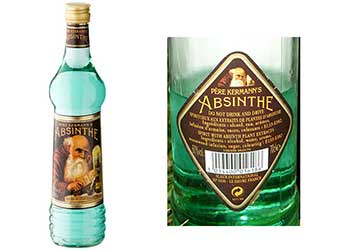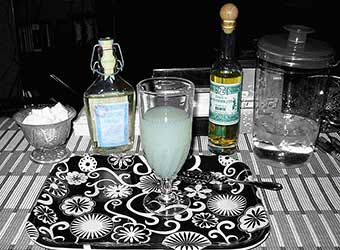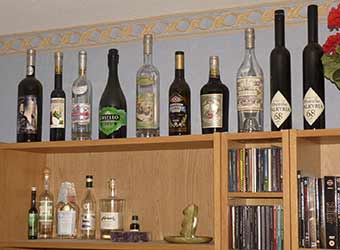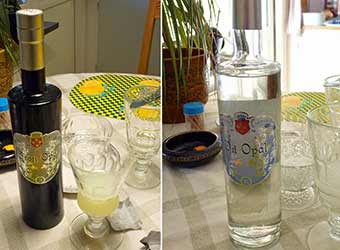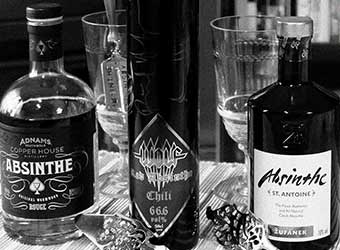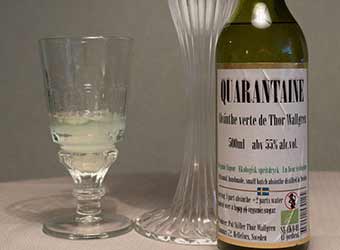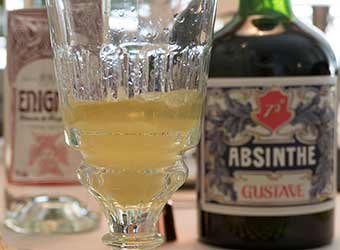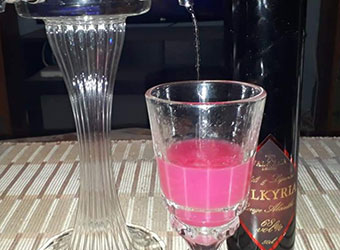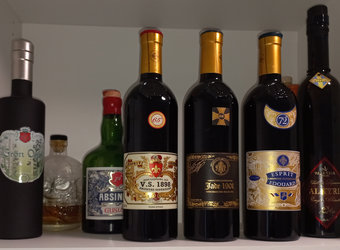Me & "my" absinthe
Experiences and Reflections
 So, how did I come up with the idea of having absinthe as my hobby?
So, how did I come up with the idea of having absinthe as my hobby?
Well, a lot of people are into beer or wine, and some even produce these drinks themselves as a hobby, since home brewing isn’t illegal. Then there’s also a large number of people (mostly men, I’d imagine) who have whisky as a big interest and hobby. They can sit for hours discussing different methods of production, the character and nuances of the drinks, history, rules, laws, and traditions. But I, always trying to be a bit "different", have simply ended up becoming fascinated with absinthe.
In the beginning, my interest in absinthe was actually quite small. But I was still a bit fascinated by that "forbidden" drink that was "illegal", that might cause hallucinations or at least had certain psychotropic traits, and yet could be bought (legally, over the counter) in the former Czechoslovakia — and even in Denmark, of all places. At least, that’s what I had heard through rumors. Then the great Internet entered my life, more seriously so to speak, during the 1990s. Still, it took quite a while before I more or less happened to stumble across information that absinthe ("real" absinthe) was actually available for purchase in countries such as Germany — both over the counter and via the Internet. Being the somewhat skeptical — or cautious, if you prefer — person that I am, it still took some time before I finally dared to buy two small bottles of absinthe to try. This was in early March 2010. But first, I wanted to find out a little more... I simply felt compelled to learn what the truth really was.
So; would I get a trip (a.k.a. "trip balls") from drinking absinthe? Would I risk getting fined, or maybe an even harsher punishment, if I tried to bring absinthe through customs? Was absinthe really something for me (in short)? And what on earth does absinthe actually taste like?
These were questions I felt I needed to get at least some answers to. So, I did what people usually do: I googled. And lo and behold, the internet had plenty to offer. Wikipedia, Systembolaget (the Swedish monopoly), Absinthe.se, The Wormwood Society, and La Fée Verte turned out to be gold mines. Wikipedia gave a quick overview. Systembolaget’s site showed that — yes, damn it! — they actually sold absinthe (a few varieties as special orders). Absinthe.se, which despite the creator and the domain is in English, provided more substance with solid history and a good number of reviews. Finally, I registered on the Wormwood Society’s online forum, where I could ask questions and got very good answers. At that time, the discussions were mostly about which brands I was recommended to try, and perhaps more importantly, which ones I should definitely avoid. If I remember correctly, Père Kermann’s Absinthe (see the first picture below) was available through Systembolaget, but everyone told me to avoid it like the plague — and I’m quite happy about that today. (My curiosity, though, about trying a prime example of a fake product grew later on, but at first I was mainly focused on experiencing the real thing.)
As for the descriptions of the taste that I had read, none of it was discouraging to me in any way. Still, I was very pleasantly surprised when I finally got to try my first two types of absinthe in early March 2010 (see the second picture below). First of all, I’m not particularly fond of the taste of strong liquor by itself, but when I took my first sips of absinthe, it was like drinking cool and refreshing velvet... like breathing a crisp Alpine breeze... with a fresh, licorice-like flavor of anise and fennel, mixed with hints of herbal spiciness and a touch of freshly cut grass. I was hooked!
The Deepening of My Knowledge
Absinthe basically became a hobby right away. There was quite a lot to explore. In the beginning, it was mostly about different accessories, apart from selecting varieties and brands of the drink itself to try over time. I got a glass and an absinthe spoon with my first purchase, but of course, there were so many other things, like different styles of glasses and spoons. Some other items I dismissed fairly quickly though, since some of it felt a bit gimmicky to me. Other things I simply thought were just too expensive, such as an absinthe fountain, which had to remain a matter for much later. So, as far as accessories were concerned, I managed just fine with a regular plastic pitcher for the ice water, but I would indeed need a few more glasses and some additional spoons.
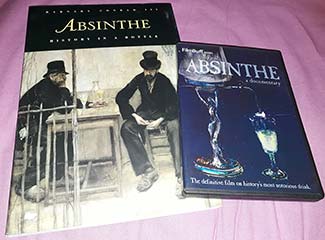 Then the exploration of absinthe’s history also began to take off more seriously. I read most of it online and managed to watch some of it in different videos*, but as my interest grew I bought the book Absinthe – History in a Bottle by Barnaby Conrad III, which goes through much of the history from absinthe’s glory days. A little later, I also bought a DVD, Absinthe – A Documentary (now also available on YouTube for free) which covers the somewhat more modern history. Recently I also acquired another book, "Absinthe - The Exquisite Elixir" by Betina J. Wittels (Author) and T.A. Breaux (Editor).
Then the exploration of absinthe’s history also began to take off more seriously. I read most of it online and managed to watch some of it in different videos*, but as my interest grew I bought the book Absinthe – History in a Bottle by Barnaby Conrad III, which goes through much of the history from absinthe’s glory days. A little later, I also bought a DVD, Absinthe – A Documentary (now also available on YouTube for free) which covers the somewhat more modern history. Recently I also acquired another book, "Absinthe - The Exquisite Elixir" by Betina J. Wittels (Author) and T.A. Breaux (Editor).
*) When it comes to online videos, I would also highly recommend a lecture by Ted Breaux that he gave in October 2010 for the Culinary Historians of Southern California - History of the Green Fairy: Absinthe (on Vimeo).
But of course, it was hardly enough just to read and watch films about its history. There are actually myths and outright misconceptions to tackle as well, which I sometimes get involved in. Among them, the eternal question: what is absinthe, and what is not absinthe? As long as there is no proper designation of origin similar to what exists for, say, champagne or Scotch single malt whisky, we will have to put up with less scrupulous producers making counterfeits and sometimes outright scams. I don’t want to mention any names here, but I know of at least two kinds of ??? (read: “crapsinthe”) that are marketed with the claim that they contain 100 mg/kg of thujone. One of these "products" is currently being sold (as of June 2016) for €179 (around 1,600 SEK), and that’s for a single (!) 75 cl bottle. The other is being sold—discounted, in fact—for £90 (about 1,000 SEK), and we’re talking about just one (!) 70 cl bottle... My God! *facepalm*
The battle is far from over.
Images and Photos
Here are a few pictures from my own absinthe journey.
A few comments about the pictures:
The first shows a brand (Père Kermann’s) that I actually haven’t tried. Instead, it’s the one I was warned about before I decided to try two others, which received much more positive reviews when I asked around. As for Père Kermann’s, you can note the color, which hardly looks natural, and the ingredient list, which includes both flavorings (?), an infusion of wormwood (hardly any distillate, in other words), sweetening in the form of added sugar, and, as mentioned, artificial coloring.
The two varieties I tried the first time (the second picture) and that really got my absinthe hobby going were Mercier Abisinthe 72 and Verte de Fougerolles. The former was, at least in hindsight, somewhat unbalanced and rather mild, but the latter was significantly more flavorful.
The third picture, showing "My Collection", is far from current and is missing some brands that I have tried since then, such as Grön and Vit Opal (which is shown in the sixth picture and.. IMHO two of the very best in the world and each in their own category (verte and blanche), perhaps only surpassed by the Jades, as far as I'm aware of) as well as, for example, Duplais Verte, La Maison Fontaine Blanche, Jade 1901 (picture no. 4), Harlequin, Lucid, Blanche Neige, Enigma Blanche, Gustave, Apocalypse, Adnams Rouge, and Valkyria Rouge… in addition to a number of less successful varieties and some outright fake ones… and unfortunately even a really bad crapsinthe.
In the fourth-to-last picture, which is from October 2018, I put together a display cabinet for my absinthe collection. Ideally, bottles with at least green (or colored) absinthe should be stored in a dark and fairly cool place, though not cold, so that the chlorophyll (or coloring agents) does not break down. Otherwise, the contents risk turning slightly brownish—a process usually called "feuille morte", which roughly means "dead leaves". According to reports, this (color) change does not affect the taste. Dark bottles offer some protection. Most of what’s in the cabinet, however, has already been consumed… unfortunately.
The third-to-last picture shows a type of bottling that one would normally want to avoid; namely, bottles and labels that reference death, hallucinations (thujone?), and other "unpleasant" things. This particular skull bottle, however, contains something quite unusual (in this type of bottle, that is): a completely ordinary and genuine absinthe called Apocalypse.
And then the second-to-last picture. It shows quite a peculiar addition at the time of writing. It is the Swedish Valkyria Rouge, with flavors of chili and licorice, in addition to the base ingredients, wormwood, fennel, and anise, of course (without which it wouldn’t be absinthe). A fantastic combination that is not as spicy as Wolf Chili (also produced by Valkyria Distillery). The color of Valkyria Rouge may not look very natural, but even though it doesn’t come from the plant kingdom, believe me… it’s at least not from any chemical source. (Here on Wikipedia, the truly curious can read more about what it’s made of.)
And the last picture then. It shows my latest additions (at the time of writing this, sept 15 2025) and it's those three phenomenal Jades, supposed to be the very best on the market.
If you would like to ask me anything specifically about absinthe, I am happy to receive such questions by email. In that case, you can reach me at contact.me(a)sethpylad.se.
I hope the information here on my absinthe pages has been interesting, and perhaps even somewhat helpful. :-)
